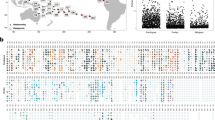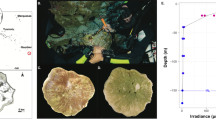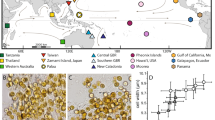Abstract
IN the rich biota of reef communities, one of the best known symbiotic relationships is that of dinoflagellates known as “zooxanthellae” with corals and giant clams1–3. In contrast, the presence of algae in ascidians (sea squirts: Phylum Chordata, Subphylum Tunicata), although known for many years, has been studied very little. It is known that the association is confined to tropical ascidians in the family Didemnidae, but even the phylum to which the algae belong, or indeed whether the green cells in question are algae at all, has remained uncertain. During a recent expedition of the RV Alpha Helix to the Great Barrier Reef, we encountered several species of colonial asdidians containing large numbers of bright green, spherical cells. We have established by optical and electron microscopy that these green cells are blue-green algae; their association with primitive chordates represents a considerable extension of the known host range of these prokaryotes.
This is a preview of subscription content, access via your institution
Access options
Subscribe to this journal
Receive 51 print issues and online access
$199.00 per year
only $3.90 per issue
Buy this article
- Purchase on Springer Link
- Instant access to full article PDF
Prices may be subject to local taxes which are calculated during checkout
Similar content being viewed by others
References
McLaughlin, J. A., and Zahl, P. A., in Symbiosis (edit, by Henry, S. M.), 1, 257–297 (Academic, New York, 1966).
Muscatine, L., and Greene, R. W., Int. Rev. Cytol., 36, 137–169 (1973).
Taylor, D. L., Adv. mar. Biol., 11, 1–56 (1973).
Hastings, A. B., Sci. Rept G. Barrier Reef Exped. 1928–29, Brit. Mus. (Nat. Hist.), iv, 69–109 (1931).
Smith, H. G., A. Mag. not. Hist., 15, 615–626 (1933).
Tokioka, T., Bull. US natn. Mus., 251, 1–247 (1967).
Droop, M. R., in Symbiotic Associations (edit. by Nutman, P. S., and Mosse, B.), 171–199 (Cambridge University Press, London, 1963).
Herdman, W. A., R. Soc. Lond. Rept Pearl Oyster Fisheries Manaar, v, 295–348 (1906).
Feldman, J., Arch. Zool. exp. gén., 75, 381–404 (1933).
Sarà, M., Marine Biol., 11, 214–221 (1971).
Sarà, M., and Liaci, L., Boll. Zool., 31, 55–65 (1964).
Vacelet, J., J. Microscopie, 12, 363–380 (1971).
Author information
Authors and Affiliations
Rights and permissions
About this article
Cite this article
NEWCOMB, E., PUGH, T. Blue-green algae associated with ascidians of the Great Barrier Reef. Nature 253, 533–534 (1975). https://doi.org/10.1038/253533a0
Received:
Revised:
Issue Date:
DOI: https://doi.org/10.1038/253533a0
This article is cited by
Comments
By submitting a comment you agree to abide by our Terms and Community Guidelines. If you find something abusive or that does not comply with our terms or guidelines please flag it as inappropriate.



